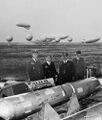Template:Selected anniversaries/March 19: Difference between revisions
No edit summary |
No edit summary |
||
| Line 13: | Line 13: | ||
||1876: Rudolf Goldschmidt born ... engineer and inventor. In 1908 he developed a rotating radio-frequency machine, the Goldschmidt alternator, which was used as an early radio transmitter. He also invented a mechanical device, the Goldschmidt tone wheel, used in early radio receivers to receive the new continuous wave radiotelegraph signals. Pic. | ||1876: Rudolf Goldschmidt born ... engineer and inventor. In 1908 he developed a rotating radio-frequency machine, the Goldschmidt alternator, which was used as an early radio transmitter. He also invented a mechanical device, the Goldschmidt tone wheel, used in early radio receivers to receive the new continuous wave radiotelegraph signals. Pic. | ||
||1876: John Marshall born ... archaeologist who was director general of the Indian Archaeological Survey (1902-31). His aim was to bring to life Indian culture in the past by uncovering all possible details of her cities, tools, ornaments, laws and customs. In the 1920's, Marshall he began a systematic program of excavations that revealed Harappa and Mohenjo-daro, the two largest cities of the previously unknown Indus Valley Civilization, which he firmly believed was comparable in every way with the ancient civilizations of Egypt and Mesopotamia. He excavated Taxila, Vaisali, Nalanda, Rajagriha and Sarnath; enacted the Ancient Monuments Act (1904), built up a library, reorganised publications and recruited Indians to high positions in the Survey. Pic. | |||
||1883: Norman Haworth born ... chemist and academic, Nobel Prize laureate .. vitamin C. Pic. | ||1883: Norman Haworth born ... chemist and academic, Nobel Prize laureate .. vitamin C. Pic. | ||
| Line 45: | Line 47: | ||
||1965: The wreck of the ''SS Georgiana'', valued at over $50,000,000 and said to have been the most powerful Confederate cruiser, is discovered by teenage diver and pioneer underwater archaeologist E. Lee Spence, exactly 102 years after its destruction. | ||1965: The wreck of the ''SS Georgiana'', valued at over $50,000,000 and said to have been the most powerful Confederate cruiser, is discovered by teenage diver and pioneer underwater archaeologist E. Lee Spence, exactly 102 years after its destruction. | ||
File:Gaston_Julia.jpg|link=Gaston Julia (nonfiction)|1978: Mathematician [[Gaston Julia (nonfiction)|Gaston Maurice Julia]] dies. He devised the formula for the Julia set. | File:Gaston_Julia.jpg|link=Gaston Julia (nonfiction)|1978: Mathematician [[Gaston Julia (nonfiction)|Gaston Maurice Julia]] dies. He devised the formula for the Julia set. | ||
| Line 54: | Line 54: | ||
File:Louis de Broglie.jpg|link=Louis de Broglie (nonfiction)|1987: Physicist and academic [[Louis de Broglie (nonfiction)|Louis de Broglie]] dies. He postulated the wave nature of electrons and suggested that all matter has wave properties. He won the Nobel Prize for Physics in 1929, after the wave-like behavior of matter was first experimentally demonstrated in 1927. | File:Louis de Broglie.jpg|link=Louis de Broglie (nonfiction)|1987: Physicist and academic [[Louis de Broglie (nonfiction)|Louis de Broglie]] dies. He postulated the wave nature of electrons and suggested that all matter has wave properties. He won the Nobel Prize for Physics in 1929, after the wave-like behavior of matter was first experimentally demonstrated in 1927. | ||
||1996: Chen Jingrun dies ... mathematician who made significant contributions to number theory. | ||1996: Chen Jingrun dies ... mathematician who made significant contributions to number theory. Pic. | ||
||2003: Nancy Farley "Nan" Wood dies ... a member of the Manhattan Project and a business owner who designed, developed and manufactured her own line of ionizing radiation detectors. She was a lifelong feminist and a founding member of Chicago NOW. | ||2003: Nancy Farley "Nan" Wood dies ... a member of the Manhattan Project and a business owner who designed, developed and manufactured her own line of ionizing radiation detectors. She was a lifelong feminist and a founding member of Chicago NOW. Pic search maybe: https://www.google.com/search?q=Nancy+Farley+"Nan"+Wood | ||
||2008: GRB 080319B: A cosmic burst that is the farthest object visible to the naked eye is briefly observed. | ||2008: GRB 080319B: A cosmic burst that is the farthest object visible to the naked eye is briefly observed. | ||
Revision as of 13:15, 19 March 2019
1816: Physician and activist Filippo Mazzei dies. He acted as an agent to purchase arms for Virginia during the American Revolutionary War.
1958: Army research laboratories convert modern plowshares into ancient swords. Industrialist and alleged supervillain Baron Zersetzung declares the technique "an astonishing breakthrough, and a milestone in military-industrial contract fulfillment."
1978: Mathematician Gaston Maurice Julia dies. He devised the formula for the Julia set.
1979: Accidental release of Carnivorous dirigibles blamed for outbreak of crimes against mathematical constants.
1987: Physicist and academic Louis de Broglie dies. He postulated the wave nature of electrons and suggested that all matter has wave properties. He won the Nobel Prize for Physics in 1929, after the wave-like behavior of matter was first experimentally demonstrated in 1927.
2017: Steganographic analysis of Spinning Thistle accidentally releases the criminal mathematical function Gnotilus.




